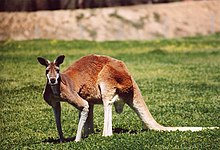
The kangaroo industry in Australia is based on the regulated harvesting of species of kangaroos.

The kangaroo industry in Australia is based on the regulated harvesting of species of kangaroos.


Australia commercially produced kangaroo meat since 1959. Annually about 3 percent of Australia’s 50 million kangaroos are utilized for their meat, which is served in many Australian restaurants and sold in some supermarkets. It is also exported to over 60 countries overseas. [1] Various pet food companies offer animal feed based on kangaroo or including kangaroo.
Since kangaroos emit smaller amounts of methane compared to cattle and sheep, their meat is sometimes advertised in this context. Australia's beef industry is estimated to account for about 11 percent of the country's carbon emissions. [2]
Various products are made from the skins of the animals. Kangaroo leather is a strong, light leather, which is more stretchy than goat or cattle but also wrinkles more easily and darkens faster. It is commonly used for shoes, motorcycle suits, handbags, wallets and in whips. Big brands usually market it as “k-leather”. Since many people see kangaroos as pest animals (and numbers have to be limited with annual culling) using the leather, when the meat is also utilized is seen as sustainable. [3]
Of the 48 species of macropods (kangaroos) in Australia, only six abundant species are allowed to be used commercially. [4]
The kangaroo industry, which represents a large amount of the commercial meat and leather traders, calls the shooting of kangaroos ″commercial kangaroo harvest″. They advocate applying under regulated quotas for the limitation of kangaroo populations, because they can overgraze, which can lead to both, a loss of biodiversity, and conflicts with farmers. As the kangaroos are not farmed, they spend their lives in their natural habitat. The shooting of certain quotas is permitted in six of eight Australian states and some additional areas with large kangaroo populations. [5]
According to the kangaroo industry, the limitation of the kangaroo population is the key ″to ensure conservation and animal welfare″ while ″health and safety standards are upheld″. Each state government has its own kangaroo management plan to estimate their populations and outline the hunting quotas. [5]
Most kangaroos are hunted in the arid grazing rangelands. [6]
According to the Australian Department of Agriculture, Water and the Environment, each year about 3 percent of Australia’s 50 million kangaroos are used for meat production, which means around 1.5 million animals. The meat of following species is exported as kangaroo meat; [1]

The National Parks and Wildlife Service South Australia authority must have a detailed management plan for the commercial reduction of the kangaroos, which is approved by the federal conservation department. Detail of the population monitoring and quota-setting controls must be renewed every five years. [4]
After the kangaroo population has been estimated, the approved shooting quota is limited to a maximum of 15 to 20 percent of the total population. However usually only about 3 percent of the kangaroos are killed due to the limited demand of the market for kangaroo products. According to the reports published by the government Queensland used only 21 percent of its annual quota and New South Wales just 15 percent in 2014. [1]
Only licensed shooters are allowed to kill kangaroos for commercial uses. [7] [8]
The official name for the ″Professional Kangaroo Shooter’s Licence″ [7] the Government of New South Wales came up with is ″professional kangaroo harvester licence″. [8]
To purchase the tags issued by the authorities, each kangaroo hunter must be licensed as such. Rules for commercial hunters differ from those for private people, who want to obtain a license. In order to obtain a private license, mandatory training has to be attended. The training has to be provided delivered by government-accredited agencies and approved by the Australian Tertiary and Further Education agency in the appropriate State. Hunters are taught about regulatory controls and compliance requirements, the animal welfare controls, and the hygiene controls. They must then pass assessment and adhere to the governmental rules before they are allowed to apply for a license. [8] [7]
The ‘National code of practice for the humane shooting of kangaroos and wallabies for non-commercial purposes’ specifies the minimum high-calibre hunting weapon which are permitted, and requires all animals to be head-shot. Besides that the 20 pages include the direction to kill injured animals immediately and descriptions of how to kill ″any dependent young″ after a mother was shot (which means hunters are required to examine the pouch as well). [9]

Eastern grey kangaroos reach a very high density in some areas of the Australian Capital Territory. The kangaroos are described as they compete for surface water, damage fencing and farm crops. Shooting kangaroos in rural areas in order to limit their numbers and the damage to farm assets, has not only been common practice for a long time, it continues to be practiced throughout Australia today. Recently concerns have arisen, regarding the impact the overgrazing by large kangaroo populations on other species and ecological communities. Due to overgrazing habitats can change due to soil erosion and a decline in water quality as recent studies have confirmed. [10]

As native animals, kangaroos were usually not considered a threat to the vegetation of their natural habitat. In 2022 a study by the University of New South Wales has illustrated that kangaroo overgrazing in nature reserves impairs soils and vegetation, and thus endangers the biodiversity. The impact of overgrazing includes that less rainwater can be absorbed by the soil. [11]
Four conservation reserves in semi-arid parts of Australia were observed by the researchers. The critically endangered Plains Wanderer (″Pedionomus torquatus″), of which less than 1.000 birds still live in the wild, needs vegetation for both cover and food. Where kangaroo overgrazing leads to both a lower plant diversity and fewer plants, the consequence is less food and shelter for other animals. Fenced sections in natural reserves are especially designed to keep unwanted animals (such as kangaroos and rabbits) outside, so that the native vegetation can regenerate. Without these efforts some rare species, might not survive. [11]
The conservation of the ecosystem calls for a balance, so if too many kangaroos have a negative impacts on it, this requires and justifies the management of the native kangaroo populations in conservation reserves. Dingos are the only non-human predators to limit the growth of kangaroo populations. [11]
A project conducted by NSW Department of Agriculture, employed a field study and computer modeling techniques, to find out why kangaroo populations are so resilient to being limited in accordance with set quotas. The project showed that between 20 and 40 percent of any area will rarely be visited by a kangaroo hunters because the terrain is too rough or other limitations make it not economic to do so. These areas then serve as ‘refugia’ areas, in which the resident kangaroo population is never hunted and from which the population expands to repopulate areas in which kangaroos are shot regularly. [12]
Several trials have indicated uncontrolled kangaroo numbers present a risk to plant biodiversity, especially when overgrazing occurs. [10] [11] Kangaroos can not be commercially hunted in National Parks; as a result, their numbers often rise to excessive levels which sometimes require culling programs to be used. In biodiversity monitoring done following a cull at Hattah-Kulkyne National Park in Victoria, increased abundance of 20 rare or threatened plant species was recorded in areas where kangaroo were culled compared with control areas (Sluiter et al. 1997). [13]
To date, agricultural development in Australia has largely been based on modified European systems, using European animals. In recent decades, this Eurocentric view has come under academic question. If Australians want to develop their own management systems, systems adapted to European conditions have to be replaced. [14]
A project implemented by University of New South Wales aimed at encouraging the development of farm enterprises based on using native plants and animals (specifically kangaroos). The project intends to monitor the environment benefits that accrue from doing so. [15]

Kangaroos are marsupials from the family Macropodidae. In common use the term is used to describe the largest species from this family, the red kangaroo, as well as the antilopine kangaroo, eastern grey kangaroo, and western grey kangaroo. Kangaroos are indigenous to Australia and New Guinea. The Australian government estimates that 42.8 million kangaroos lived within the commercial harvest areas of Australia in 2019, down from 53.2 million in 2013.
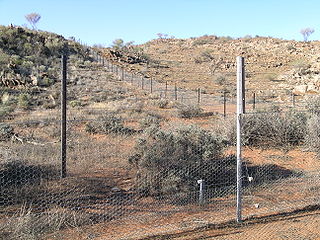
Overgrazing occurs when plants are exposed to intensive grazing for extended periods of time, or without sufficient recovery periods. It can be caused by either livestock in poorly managed agricultural applications, game reserves, or nature reserves. It can also be caused by immobile, travel restricted populations of native or non-native wild animals.

The Murray-Sunset National Park is the second largest national park in Victoria, Australia, located in the Mallee district in the northwestern corner of the state, bordering South Australia. The 633,000-hectare (1,560,000-acre) national park is situated approximately 440 kilometres (270 mi) northwest of Melbourne and was proclaimed in 1991. It is in the northwestern corner of the state, bordering South Australia to the west and the Murray River to the north. The Sturt Highway passes through the northern part of the park, but most of the park is in the remote area between the Sturt Highway and the Mallee Highway, west of the Calder Highway.

Conservation in Australia is an issue of state and federal policy. Australia is one of the most biologically diverse countries in the world, with a large portion of species endemic to Australia. Preserving this wealth of biodiversity is important for future generations. 25% of Australia is managed for conservation.

The eastern grey kangaroo is a marsupial found in the eastern third of Australia, with a population of several million. It is also known as the great grey kangaroo and the forester kangaroo. Although a big eastern grey male can typically weigh up to 69 kg (152 lb) and have a length of well over 2 m, the scientific name, Macropus giganteus, is misleading: the red kangaroo of the semi-arid inland is larger, weighing up to 90 kg (200 lb).

The red kangaroo is the largest of all kangaroos, the largest terrestrial mammal native to Australia, and the largest extant marsupial. It is found across mainland Australia, except for the more fertile areas, such as southern Western Australia, the eastern and southeastern coasts, and the rainforests along the northern coast.

The western grey kangaroo, also referred to as a western grey giant kangaroo, black-faced kangaroo, mallee kangaroo, sooty kangaroo and Kangaroo Island grey kangaroo, is a large and very common kangaroo found across almost the entire southern part of Australia, from just south of Shark Bay through coastal Western Australia and South Australia, into western Victoria, and in the entire Murray–Darling basin in New South Wales and Queensland.

In agriculture, grazing is a method of animal husbandry whereby domestic livestock are allowed outdoors to free range and consume wild vegetations in order to convert the otherwise indigestible cellulose within grass and other forages into meat, milk, wool and other animal products, often on land that is unsuitable for arable farming.
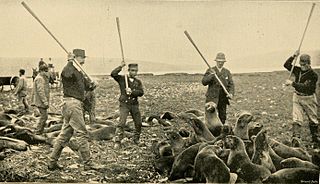
Seal hunting, or sealing, is the personal or commercial hunting of seals. Seal hunting is currently practiced in nine countries: Canada, Denmark, Russia, the United States, Namibia, Estonia, Norway, Finland and Sweden. Most of the world's seal hunting takes place in Canada and Greenland.
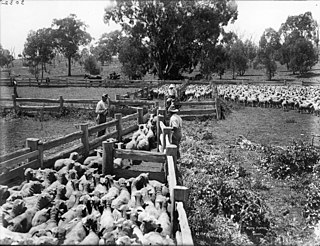
Culling is the process of segregating organisms from a group according to desired or undesired characteristics. In animal breeding, it is removing or segregating animals from a breeding stock based on a specific trait. This is done to exaggerate desirable characteristics, or to remove undesirable characteristics by altering the genetic makeup of the population. For livestock and wildlife, culling often refers to killing removed animals based on their characteristics, such as their sex or species membership, or as a means of preventing infectious disease transmission.

Kangaroo meat is produced in Australia from wild kangaroos and is exported to over 61 overseas markets.

Wildlife trade refers to the products that are derived from non-domesticated animals or plants usually extracted from their natural environment or raised under controlled conditions. It can involve the trade of living or dead individuals, tissues such as skins, bones or meat, or other products. Legal wildlife trade is regulated by the United Nations' Convention on International Trade in Endangered Species of Wild Fauna and Flora (CITES), which currently has 184 member countries called Parties. Illegal wildlife trade is widespread and constitutes one of the major illegal economic activities, comparable to the traffic of drugs and weapons.
Kangaroo leather is a strong, lightweight leather derived from the hide of the kangaroo.
Overpopulation or overabundance is a state in which the population of a species is larger than the carrying capacity of its environment. This may be caused by increased birth rates, lowered mortality rates, reduced predation or large scale migration, leading to an overabundant species and other animals in the ecosystem competing for food, space, and resources. The animals in an overpopulated area may then be forced to migrate to areas not typically inhabited, or die off without access to necessary resources.

The Barmah National Park, formerly Barmah State Park, is a national park located in the Hume region of the Australian state of Victoria. The park is located adjacent to the Murray River near the town of Barmah, approximately 225 kilometres (140 mi) north of Melbourne. The park consists of river red gum floodplain forest, interspersed with treeless freshwater marshes. The area is subject to seasonal flooding from natural and irrigation water flows.

Feral goats are an invasive animal species in Australia. First arriving in the 18th century with European settlers, feral goat populations originated from escaped domestic individuals. Today, feral goats are found across Australia, where they cause economic and environmental damage through overgrazing and competition with livestock and native marsupials.
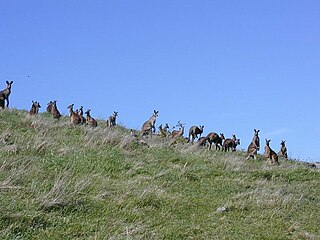
A sustainable wildlife enterprise is a farming system incorporating sustainable use of wildlife to promote conservation. In Australia, landholders work together across boundaries to harvest or make use of (ecotourism) naturally occurring wildlife populations such as the kangaroo sustainably. Important to the concept is that biodiversity and environmental benefit occurs via alternative land uses. Attaching value to native resources through commercial development has the potential to provide alternative sources of income, especially in areas where traditional systems are no longer as profitable or environmentally sustainable.
Australia has a population of about 26 million while the Commonwealth Government estimating there are 640,000 recreational hunters in the country. There are around 6 million legally owned guns in Australia, ranging from airguns to single-shot, bolt-action, pump-action, lever-action or semi-automatic firearms.
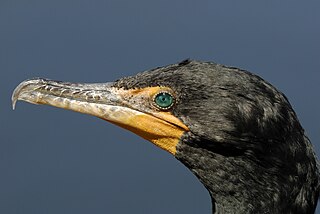
Cormorant culling is the intentional killing of cormorants by humans for the purposes of wildlife management. It has been practiced for centuries, with supporters of culling generally arising from the angling community. Culling techniques may involve the killing of birds, the destruction of eggs, or both. Historically, culls have occurred to protect the interests of recreational and commercial fishermen who perceive the animals to be competing with them for their intended catch or for the prey of their intended catch. Since the 1960s, the growing aquaculture industry has undertaken cormorant culls to protect its farmed fish and crustacean stocks. Opponents of cormorant culling include conservation groups such as the National Audubon Society, Cormorant Defenders International and Sea Shepherd.
In biology, overabundant species refers to an excessive number of individuals and occurs when the normal population density has been exceeded. Increase in animal populations is influenced by a variety of factors, some of which include habitat destruction or augmentation by human activity, the introduction of invasive species and the reintroduction of threatened species to protected reserves.